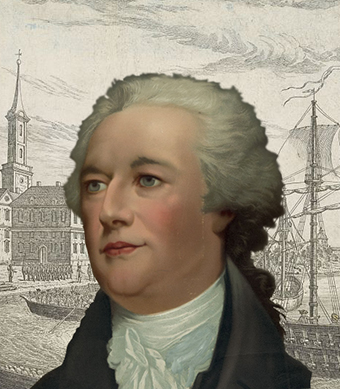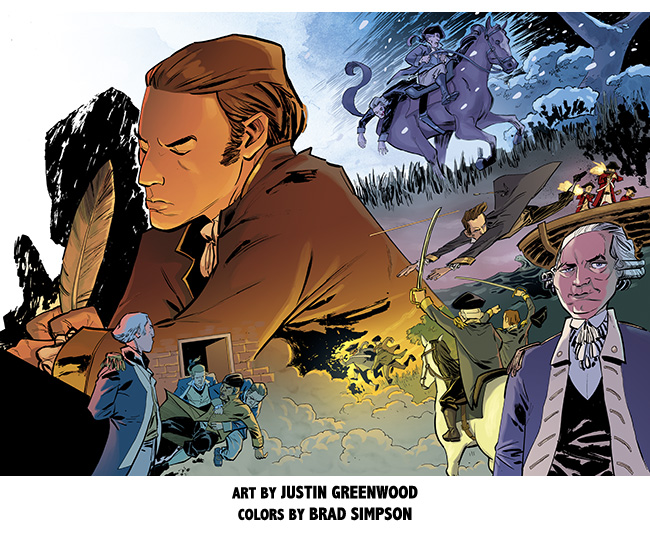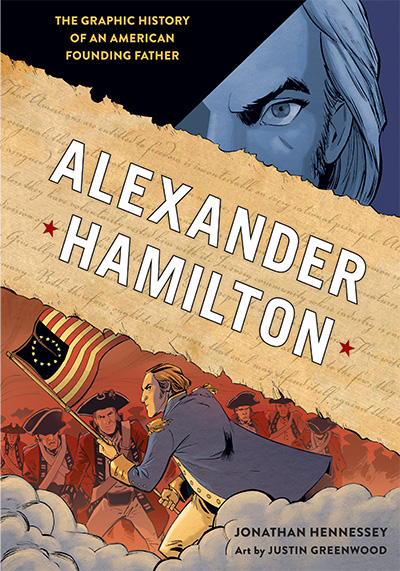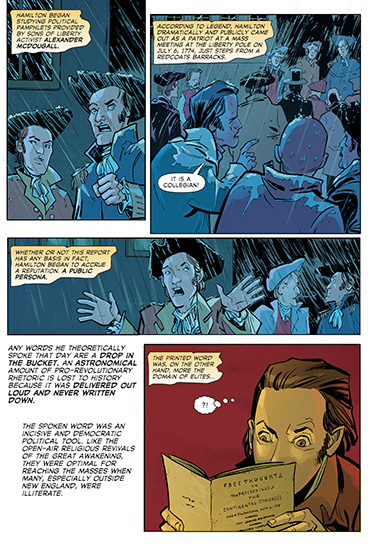It is a tremendous pleasure to be able to finally part the curtains and announce my latest book: the nonfiction biography Alexander Hamilton: The Graphic Story of an American Founding Father. It will be published August 8, 2017, by Penguin Random House imprint Ten Speed Press.
I know what you’re thinking. An Alexander Hamilton graphic novel really comes as a surprise to no one. Am I right? After all, there is one marquee reason why our nation’s premiere “man behind the man” and first Treasury Secretary, as a subject, has suddenly detonated with high-yield topicality.
No—that marquee reason is not so much because of the Broadway smash Hamilton: An American Musical. Though clearly that cultural sensation has not put a crimp in the man’s knack for staying relevant. (By the way, Hamilton lived with an abiding, personal fantasy of bucking tremendous odds to become the stuff of myth and legend. The big stage musical and all the attention it has garnered has done more to fulfill that fantasy than any statue, society, or doorstop-sized monograph that have graced the man since his 1804 death.)
It’s a better time than ever for an Alexander Hamilton nonfiction graphic book because we Americans have seldom argued so voraciously about what the proper size, scope, and mission of the federal government should to be. And you can’t even start having that conversation until you get to know Alexander Hamilton.
Such was his supercharged influence in the 1780s and 1790s, when the United States as a nation was just getting underway, that the term “Hamiltonian” has literally come to define one entire pole of the two time-honored approaches to American government.
 The bare essence of the “Hamiltonian” tradition is “big government.” (Though it must be understood that both what was considered appropriate and what was actually possible in the late 18th Century barely scales to today). Hamiltonian politics are marked by a strong, energetic president and a less eminent Congress; weighty and far-reaching federal government projects paid for by taxes and the taking on of debt; urban-oriented banking and manufacturing interests dominating agriculture; an extensive and well-funded military; and a robust enforcement of federal law over state prerogatives.
The bare essence of the “Hamiltonian” tradition is “big government.” (Though it must be understood that both what was considered appropriate and what was actually possible in the late 18th Century barely scales to today). Hamiltonian politics are marked by a strong, energetic president and a less eminent Congress; weighty and far-reaching federal government projects paid for by taxes and the taking on of debt; urban-oriented banking and manufacturing interests dominating agriculture; an extensive and well-funded military; and a robust enforcement of federal law over state prerogatives.
As an idea, Hamiltonian politics have always been the whipping boy of the other pillar of American governmental philosophy. This alternative tradition—which swiftly took over in Hamilton’s later years and reigned for decades—is of course credited to Hamilton’s archrival Thomas Jefferson. To say nothing of political parties, since they have changed over time far more than most Americans give them credit for, the modern conservative movement largely springs from Jeffersonian political ideals.
Getting to know Hamilton, his life, his personality, and his times, is to examine the very chromosomes of American politics and culture. To understand where he came from is to begin to understand where we came from.
But wait. Other than a primer to help appreciate where we’ve been and get a handle on our current political times, there’s a whole other reason to pick up a good Hamilton book.
 The man was a mercurial, thrusting, larger-than-life character whose years traced an incredible roller coaster of triumphs and misfortunes. During the American Revolution Hamilton often took to battle with the ardor of a man embracing a death-wish. After years of willing subordination as an aide de camp to the towering physical and authoritative presence of George Washington, one minor insult whipped Hamilton into such a froth of indignation that he told the general off. Hamilton’s high-octane opinions on law and leadership blew the powdered wigs off half the luminaries at the convention where they wrote the U.S. Constitution. And no great man of his time had a better capacity for dealing himself self-inflicted wounds. We see this when Hamilton became the center of a roiling, oh-no-he-didn’t public sex scandal. And then, as if he had learned nothing, Hamilton made himself the scourge of the very political movement he’d helped build. This he achieved by taking public and doubling down on the fierce criticism he had whispered about one of his movement’s own leaders.
The man was a mercurial, thrusting, larger-than-life character whose years traced an incredible roller coaster of triumphs and misfortunes. During the American Revolution Hamilton often took to battle with the ardor of a man embracing a death-wish. After years of willing subordination as an aide de camp to the towering physical and authoritative presence of George Washington, one minor insult whipped Hamilton into such a froth of indignation that he told the general off. Hamilton’s high-octane opinions on law and leadership blew the powdered wigs off half the luminaries at the convention where they wrote the U.S. Constitution. And no great man of his time had a better capacity for dealing himself self-inflicted wounds. We see this when Hamilton became the center of a roiling, oh-no-he-didn’t public sex scandal. And then, as if he had learned nothing, Hamilton made himself the scourge of the very political movement he’d helped build. This he achieved by taking public and doubling down on the fierce criticism he had whispered about one of his movement’s own leaders.
To put this another way, Hamilton was all but a headline-grabbing, love him or love-to-hate-him reality star of the Early Republic. His biography is such a sawtooth pattern such of tragedy and success that you have to see it to believe it. No other Founding Father’s story deserves the immersive and cinematic telling that the talents of illustrator Justin Greenwood and color artist Brad Simpson bring to life, and I am so proud to have collaborated with them on this book.
I have seen it wisely put that the Founding Era of the United States was a particularly “deliberative” moment in world history. A time unlike almost any other.
Because, arguably, never before had so many people had the chance to seize control of their political destiny and influence their future. That is why we who came generations—even many generations—later owe such honor and allegiance to what was said, done, thought, and written immediately preceding and following on from the American Revolution.
Given the political upheavals of the last years, it is hard not to think that Americans (and not Americans alone) are facing another great deliberative moment.
This is why it is so crucial right now to turn back to the stories, testaments, and works of the people who were lucky enough to survive the Revolutionary War—and also happened to be talented and tenacious enough to define why and for what that blood had been shed.
Like my other books, Alexander Hamilton: The Graphic History of American Founding Father takes thorough and wide-ranging research and uses the comics medium to breathe life into history that is, all too often, far less rewarding to read in conventional form.
To produce the book, hundreds upon hundreds of images were culled from books and archives. This makes every panel rich with accurate and historical detail, from French and Indian War weapons and uniforms to the route of George Washington’s funeral procession.
The rich resources of the Huntington Library, the Library of Congress, and the National Park Service have been brought to bear to insure that this work can stand both aside and apart from any other Hamilton book out there. And lastly, it gives me pleasure to note that I have already written somewhat extensively about Hamilton in two out of my three previous books: 2008’s The U.S. Constitution: A Graphic Adaptation and 2013’s The Gettysburg Address: A Graphic Adaptation. Getting the chance to devote an entire book to him was amazing.
Unlike George Washington, Benjamin Franklin, and Thomas Jefferson, Hamilton did not make an appearance in my 2015 co-authored The Comic Book Story of Beer.
But—believe it or not—Hamilton did play a part in a whoppingly influential episode that figures both into the history of American beer and the history of American and international jurisprudence!
So think of my next blog piece to come as a Comic Book Story of Beer and Alexander Hamilton: The Graphic History of an American Founding Father crossover. Watch this space!
Meanwhile, you are cordially invited to check out the dedicated Alexander Hamilton website, preorder the book, and be on track to get all the true history that the musical leaves on the other side of Broadway’s velvet rope.


